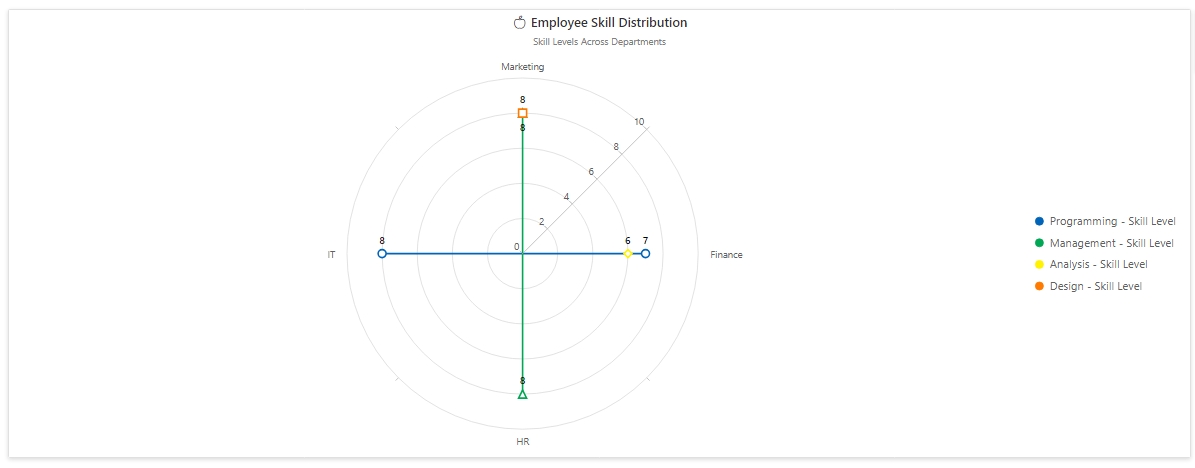Search for answers or browse articles about Sintel BI
Polar Charts
Polar charts are a type of data visualisation that displays data in a circular format, where each category is represented by a segment radiating from the centre. This format is useful for showing multivariate data and identifying patterns and trends in a radial layout.
How to Use Polar Charts
Step 1: Add the Polar Chart to Your Dashboard
- Edit Mode: Ensure your dashboard is in edit mode.
- Drag and Drop: Drag a polar chart onto your dashboard.
- Resize: Adjust the chart size as needed.
Step 2: Configure Chart Properties
- Title: Enter a title for your chart.
- Subtitle: Add a subtitle if needed.
- Icon: Choose an icon that represents the data.
- Title Alignment: Set the title alignment to left, centre, or right.
Step 3: Customise Appearance
- Elevated Borders: Enable elevated borders for a 3D effect.
- Background Colour: Change the background colour to suit your dashboard’s theme.
- Mobile Visibility: Choose to hide the chart on mobile devices if necessary.
Step 4: Basic Settings
- Show Legend: Display the legend.
- Show Value Labels: Show labels for each value.
- Show Empty Values: Choose to display empty values.
- Show Zero Values: Display zero values.
- Invert Axes: Invert the chart axes if needed.
Step 5: Axis Settings
- Value Axis: Enable or disable the value axis.
- Axis Title: Provide a title for the value axis.
- Axis Min/Max: Set minimum and maximum values for the axis.
- Axis Type: Choose between Double, Logarithmic, or Category.
- Smart Labels: Enable smart labels to abbreviate numeric axis labels.
- Category Axis: Show or hide the category axis.
- Category Axis Title: Provide a title for the category axis.
- Axis Label Rotation: Rotate axis labels for better readability.
- Tooltip: Show or shorten tooltip values for additional information on hover.
Step 6: Assign Data
- Data Source: Select the data source for the chart.
- Assign Columns: Drag columns into the value, column, and row fields.
- Sort and Series Settings: Configure sorting and series settings based on your data source.
Examples of Polar Chart Usage
Example 1: Employee Skill Distribution

Objective: Visualise the skill levels of employees across different departments.
Data Source: SharePoint List called “Employee Skills”
| Column Name | Column Type | Description |
|---|---|---|
| Employee Name | Single line of text | Name of the employee |
| Skill | Choice | Skill name (e.g., Programming, Design) |
| Department | Choice | Department (e.g., IT, Marketing) |
| Skill Level | Number | Level of skill proficiency (1-10) |
Example Data:
| Employee Name | Skill | Department | Skill Level |
|---|---|---|---|
| John Doe | Programming | IT | 8 |
| Jane Doe | Design | Marketing | 7 |
| Oscar Dunnes | Design | Marketing | 8 |
| Marge Connors | Programming | IT | 7 |
| Louise Thompson | Analysis | Finance | 6 |
| Amy Berry | Management | HR | 7.5 |
| Lily O’Brien | Management | Marketing | 8 |
| Ross Anure | Programming | Finance | 7 |
Polar Chart Configuration:
Properties:
- Title: Employee Skill Distribution
- Subtitle: Skill Levels Across Departments
- Icon: Suitable icon for skills
- Title Alignment: Centre
Appearance:
- Elevated Borders: Enabled
- Background Colour: None
- Hide on Mobile: No
Basic Settings:
- Show Legend: Enabled
- Legend Position: Right
- Legend Shape: Circle
- Show Value Labels: Enabled
- Shorten Value Labels: Enabled
- Show Empty Values: Disabled
- Show Zero Values: Disabled
- Invert Axes: No
Axis Settings:
- Show Value Axis: Enabled
- Start Angle: 45
- Show Smart Labels: Enabled
- Show Category Axis: Enabled
- Category Axis Title: Department
- Axis Label Rotation: 45 degrees
- Show Tooltip: Enabled
- Shorten Tooltip Values: No
Assign Data:
- Data Source: Employee Skills
- Value: Skill Level (Average of Skill Level)
- Column: Department
- Row: Skill
Conclusion
Polar charts in Sintel BI offer a robust way to visualise multivariate data in a radial format. By customising the chart’s properties and assigning relevant data, users can create informative and visually appealing dashboards that highlight patterns and trends effectively. Whether you’re displaying employee skills, sales performance, or customer satisfaction survey results, polar charts can enhance your data presentation and provide deeper insights.
